In today’s fast-paced digital landscape, businesses need to be agile and efficient to stay ahead of the competition. To achieve this, many organizations are turning to hybrid cloud solutions. A hybrid cloud combines the benefits of both public and private clouds, allowing businesses to leverage the best of both worlds. This strategic approach offers a powerful blend of flexibility, scalability, and cost optimization, making it an increasingly popular choice for businesses of all sizes.
This in-depth guide will explore the intricacies of hybrid cloud solutions, delving into their key advantages and how they empower businesses to achieve agility and efficiency. We will examine the various components of a hybrid cloud architecture, discuss the key considerations for successful implementation, and provide real-world examples of how organizations are leveraging hybrid cloud to transform their operations. Join us as we unlock the potential of hybrid cloud and discover how it can revolutionize your business.
What is a Hybrid Cloud Solution?
A hybrid cloud solution is a blend of public and private cloud environments, allowing organizations to leverage the benefits of both. This strategic approach offers flexibility and scalability, enabling businesses to deploy applications and workloads where they’re best suited.
Think of it as a seamless bridge between two worlds. Your private cloud, housed within your own infrastructure, provides you with enhanced control and security over sensitive data. Meanwhile, the public cloud, offered by third-party providers, delivers on-demand resources, cost-efficiency, and scalability.
By combining these two, you unlock a potent synergy. You can leverage the public cloud’s agility for workloads demanding quick scalability, while keeping sensitive data secure within your private environment. This strategic balance empowers organizations to optimize their IT infrastructure for performance, security, and cost-effectiveness.
The Benefits of Adopting a Hybrid Cloud Strategy
In today’s dynamic business landscape, organizations are increasingly turning to hybrid cloud strategies to enhance their agility and efficiency. This approach combines the benefits of both public and private clouds, allowing businesses to tailor their infrastructure to meet specific needs. By adopting a hybrid cloud, organizations can unlock a range of advantages, including:
Enhanced Flexibility and Scalability: Hybrid cloud empowers businesses to scale their resources up or down as needed, ensuring optimal performance and cost-effectiveness. Organizations can leverage the scalability of public cloud for peak demands while relying on the security and control of private cloud for sensitive data.
Cost Optimization: By strategically allocating workloads across public and private clouds, organizations can optimize costs. They can leverage the pay-as-you-go model of public cloud for less critical applications while utilizing the lower costs of private cloud for mission-critical workloads.
Improved Disaster Recovery and Business Continuity: Hybrid cloud provides robust disaster recovery and business continuity capabilities. Organizations can replicate critical data and applications to the public cloud, ensuring minimal downtime in case of disruptions at their private cloud facilities.
Increased Security: Hybrid cloud offers a layered security approach. Organizations can leverage the enhanced security controls of private cloud for sensitive data and applications while benefiting from the robust security features of public cloud providers.
Innovation and Agility: Hybrid cloud provides organizations with the flexibility to experiment with new technologies and solutions. They can easily access cutting-edge services and platforms offered by public cloud providers, accelerating innovation and time-to-market.
In conclusion, adopting a hybrid cloud strategy offers organizations a range of compelling benefits, including enhanced flexibility, cost optimization, improved disaster recovery, increased security, and accelerated innovation. By strategically combining the best of both worlds, businesses can unlock new levels of agility and efficiency, driving growth and success in the digital era.
Increased Flexibility and Scalability
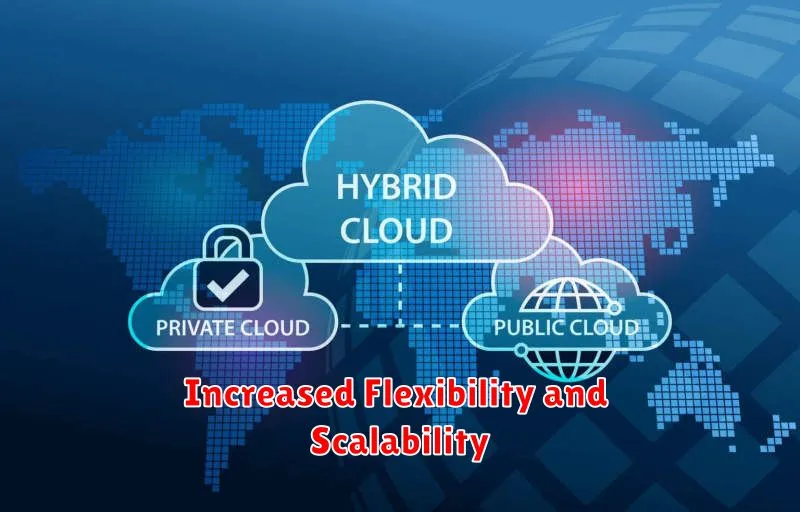
One of the most compelling benefits of hybrid cloud solutions is their ability to deliver increased flexibility and scalability. This means you can easily adapt your infrastructure to meet changing business needs, whether it’s scaling up during peak demand or downsizing during periods of low activity.
With a hybrid cloud, you have the freedom to deploy applications and workloads where they make the most sense. You can leverage the scalability of public cloud for demanding or fluctuating workloads, while keeping sensitive data and mission-critical applications securely within your on-premises environment. This flexibility gives you the ability to optimize costs and performance while maintaining control over your data.
Furthermore, hybrid cloud allows for seamless scaling of resources. If you need to quickly provision more compute power, storage, or network bandwidth, you can do so within the public cloud component of your infrastructure. This scalability is particularly valuable for businesses experiencing rapid growth or dealing with seasonal fluctuations in demand.
Enhanced Cost Optimization and Resource Allocation
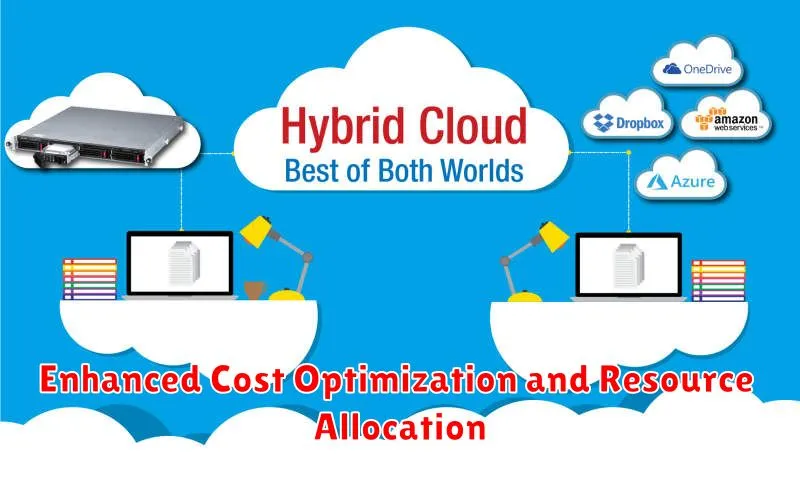
Hybrid cloud solutions empower organizations to optimize costs and allocate resources more efficiently. By leveraging the strengths of both on-premises and cloud environments, businesses can tailor their infrastructure to specific workloads, achieving a balance between performance, flexibility, and cost-effectiveness.
Cost Optimization through hybrid cloud is achieved by:
- Right-sizing workloads: Deploying applications in the most suitable environment – on-premises for high-performance, resource-intensive tasks or in the cloud for scalable, dynamic workloads.
- Pay-as-you-go model: Utilizing cloud services for burst capacity and seasonal demand, reducing capital expenditure on redundant infrastructure.
- Cost-effective storage options: Combining on-premises storage for frequently accessed data with cloud storage for backups and archives.
Resource Allocation is enhanced through:
- Dynamic provisioning: Quickly scaling resources up or down based on real-time demand, eliminating resource under-utilization and over-provisioning.
- Centralized management: Consolidating resource management across on-premises and cloud environments, providing a unified view for efficient allocation and utilization.
- Enhanced security: Implementing robust security measures across both environments, ensuring data protection and compliance regulations are met.
Hybrid cloud solutions deliver significant benefits in cost optimization and resource allocation, enabling organizations to:
- Reduce IT expenses by optimizing resource utilization and leveraging cost-effective cloud services.
- Increase agility and responsiveness by quickly adapting to changing business needs and market demands.
- Gain competitive advantage by focusing on core competencies and innovation, freed from managing complex infrastructure.
Improved Security and Compliance
Hybrid cloud solutions offer enhanced security and compliance capabilities, empowering organizations to navigate the evolving threat landscape with confidence. By combining the strengths of both public and private clouds, hybrid deployments provide a robust security posture, ensuring data protection and regulatory compliance.
One key advantage is the ability to implement stronger access controls. With hybrid cloud, organizations can isolate sensitive data in their private cloud environment, restricting access to authorized users only. This granular control significantly reduces the risk of unauthorized access and data breaches. Moreover, advanced security features offered by public cloud providers, such as threat detection and response systems, can be leveraged to further enhance the overall security posture.
Furthermore, hybrid cloud solutions simplify compliance with industry regulations, such as GDPR and HIPAA. Organizations can leverage compliant infrastructure and data governance tools provided by public cloud providers to ensure adherence to specific regulatory requirements. The flexibility of hybrid cloud enables organizations to tailor their security and compliance strategies to meet specific industry standards and legal frameworks.
By embracing hybrid cloud solutions, organizations can unlock a level of security and compliance that surpasses traditional infrastructure. The combination of on-premises control and cloud-based capabilities offers a comprehensive approach to data protection, regulatory compliance, and risk mitigation. This, in turn, enables organizations to operate with greater confidence and agility, focusing on their core business objectives.
Seamless Data Management and Integration
In the dynamic landscape of modern business, agility and efficiency are paramount. Hybrid cloud solutions emerge as a powerful enabler, offering a compelling blend of public and private cloud capabilities. At the heart of this transformative approach lies the critical aspect of seamless data management and integration. This article delves into the core benefits of this approach, exploring how hybrid cloud platforms empower businesses to unlock unprecedented levels of operational excellence.
The cornerstone of seamless data management within hybrid cloud lies in the centralized orchestration and governance of data across diverse environments. This involves establishing a unified platform that seamlessly integrates data residing in both public and private cloud infrastructures. By adopting this approach, organizations eliminate data silos and ensure a consistent view of their valuable assets, facilitating better decision-making and streamlined operations.
Furthermore, data integration plays a pivotal role in maximizing the benefits of hybrid cloud deployments. By connecting data sources across various systems and applications, organizations can leverage the power of analytics and extract actionable insights. This integration enables businesses to create a holistic understanding of their operations, identify opportunities for optimization, and drive innovation across all facets of their business.
In essence, seamless data management and integration form the bedrock of successful hybrid cloud adoption. By harnessing these capabilities, organizations gain the agility to adapt to evolving market demands, the efficiency to optimize processes, and the insights to drive strategic growth. The result is a transformative journey towards a future where data empowers every aspect of the business, unlocking unprecedented levels of operational excellence.
Use Cases for Hybrid Cloud Solutions
Hybrid cloud solutions offer a powerful and flexible approach to IT infrastructure, allowing organizations to leverage the best of both public and private cloud environments. This dynamic approach brings together the scalability and cost-effectiveness of public clouds with the security, control, and compliance advantages of private clouds. As a result, hybrid cloud has become a popular choice for businesses across various industries, enabling them to tackle a wide range of challenges and capitalize on emerging opportunities.
Here are some prominent use cases for hybrid cloud solutions:
1. Migrating Legacy Applications
Many organizations still rely on legacy applications that may not be easily adaptable to public cloud environments. Hybrid cloud provides a bridge, allowing these applications to be migrated to the private cloud while leveraging public cloud services for specific tasks like disaster recovery or data analytics. This enables a gradual migration process, minimizing disruption to business operations.
2. Scaling Up for Peak Demands
During seasonal spikes or sudden increases in workload, organizations can utilize the elastic nature of public cloud to rapidly scale up resources. Hybrid cloud allows them to seamlessly transition between public and private clouds, ensuring optimal resource utilization and cost efficiency. This is particularly beneficial for businesses experiencing fluctuating demand, like e-commerce retailers during holiday seasons.
3. Data-Intensive Workloads
Hybrid cloud solutions are ideal for handling data-intensive workloads, where processing power and storage capacity are critical. Organizations can store sensitive data within their private cloud while utilizing public cloud resources for computationally demanding tasks like data analytics and machine learning. This ensures both data security and the scalability needed for processing massive datasets.
4. Disaster Recovery and Business Continuity
Hybrid cloud provides a robust disaster recovery strategy. By replicating critical data and applications to the public cloud, organizations can quickly restore operations in case of a disaster or outage at their primary location. This ensures business continuity and minimizes downtime, protecting revenue and customer satisfaction.
5. Testing and Development
Hybrid cloud offers a flexible and cost-effective environment for testing and development. Developers can utilize the public cloud for rapid prototyping and experimentation, while leveraging the private cloud for secure and controlled production environments. This accelerates the development process and reduces the risk of errors.
6. Improving Security Posture
Hybrid cloud can enhance security by providing a multi-layered approach. Organizations can leverage the advanced security features of private clouds for sensitive data and applications, while using public cloud services like threat intelligence and security monitoring to detect and respond to potential threats. This creates a more resilient security posture.
Hybrid cloud solutions are proving to be a transformative force in the IT landscape. Their ability to combine the benefits of public and private cloud environments empowers organizations to achieve greater agility, efficiency, and cost optimization, ultimately driving innovation and success. As organizations continue to embrace digital transformation, hybrid cloud is likely to play an increasingly vital role in their journey.
Hybrid Cloud vs. Multi-Cloud: Understanding the Difference
In the dynamic world of cloud computing, two prominent architectures often take center stage: hybrid cloud and multi-cloud. While they share the common goal of leveraging cloud resources, they differ significantly in their approach and implementation. Understanding the key distinctions between these architectures is essential for businesses seeking to optimize their IT infrastructure and achieve their desired level of agility and efficiency.
Hybrid cloud combines the benefits of both on-premises infrastructure and public cloud services. This approach allows businesses to maintain control over sensitive data and legacy applications while enjoying the scalability and cost-effectiveness of public cloud platforms. The seamless integration of on-premises and cloud resources allows for a flexible and adaptable IT environment, catering to diverse workloads and security requirements.
In contrast, multi-cloud leverages multiple public cloud providers simultaneously. This strategy allows businesses to diversify their cloud resources, mitigating vendor lock-in and maximizing cost optimization. By spreading workloads across different cloud platforms, organizations gain access to a wider range of services, technologies, and pricing models. The multi-cloud approach promotes flexibility and ensures resilience, as the failure of one provider does not compromise the entire system.
While both hybrid cloud and multi-cloud offer compelling benefits, the optimal choice depends on specific business needs and priorities. Organizations with sensitive data or legacy systems may find hybrid cloud to be a more secure and manageable option, while those seeking flexibility, cost optimization, and vendor diversification may prefer multi-cloud. The key is to carefully evaluate the strengths and weaknesses of each approach and select the architecture that aligns best with your business goals and technical requirements.
Key Considerations When Implementing a Hybrid Cloud Solution
Embracing a hybrid cloud strategy can bring significant advantages, including enhanced agility, cost optimization, and improved scalability. However, navigating the transition requires careful planning and consideration of key factors. This article delves into the essential considerations when implementing a hybrid cloud solution.
1. Defining Clear Objectives and Scope:
Start by identifying your specific business goals and the applications or workloads you intend to migrate to the cloud. This clarity will help you determine the optimal hybrid cloud model and the resources needed.
2. Assessing Existing Infrastructure:
A thorough evaluation of your current on-premises infrastructure is crucial. This assessment should encompass hardware, software, applications, and security protocols to identify potential compatibility issues and ensure seamless integration with the cloud.
3. Choosing the Right Cloud Provider:
Selecting the appropriate cloud provider is critical. Consider factors such as service offerings, pricing models, security features, and geographic locations. Research different providers and choose one that aligns with your requirements and budget.
4. Ensuring Data Security and Compliance:
Data security is paramount in any cloud environment. Implement robust security measures, including encryption, access controls, and regular security audits, to safeguard sensitive information. Compliance with relevant regulations and industry standards is also essential.
5. Managing Hybrid Cloud Complexity:
Hybrid cloud environments can be complex to manage. Consider implementing automation tools and orchestration platforms to streamline operations, automate tasks, and optimize resource utilization.
6. Planning for Disaster Recovery and Business Continuity:
Develop a comprehensive disaster recovery and business continuity plan that encompasses both on-premises and cloud infrastructure. This plan should include data backups, failover mechanisms, and testing procedures to ensure minimal downtime in case of an outage.
7. Monitoring and Optimization:
Continuous monitoring of your hybrid cloud environment is vital. Utilize monitoring tools to track performance, resource utilization, and security metrics. Regularly analyze the data and make necessary adjustments to optimize performance and cost-effectiveness.
By carefully considering these factors and implementing a well-defined strategy, organizations can successfully harness the benefits of a hybrid cloud solution, unlocking new levels of agility, efficiency, and innovation.
Choosing the Right Cloud Providers for Your Hybrid Strategy

In the dynamic world of cloud computing, a hybrid cloud strategy offers businesses unparalleled flexibility and efficiency. This strategy combines the best of both worlds, leveraging the on-premises infrastructure for critical workloads while embracing the scalability and cost-effectiveness of public cloud services.
However, the success of a hybrid cloud strategy hinges on choosing the right cloud providers. This selection process demands a meticulous assessment of factors such as:
- Service Offerings: Align cloud provider capabilities with your specific requirements, considering options like infrastructure as a service (IaaS), platform as a service (PaaS), and software as a service (SaaS).
- Security and Compliance: Prioritize providers that meet your security and compliance standards, especially for sensitive data and regulated industries.
- Integration and Interoperability: Ensure seamless integration between your on-premises systems and the cloud provider’s infrastructure.
- Pricing and Cost Optimization: Compare pricing models and explore cost optimization strategies to maximize value and manage your cloud expenditure effectively.
- Support and Expertise: Evaluate the provider’s technical support, documentation, and expertise in areas relevant to your business needs.
By carefully considering these factors, you can choose cloud providers that seamlessly integrate with your hybrid cloud strategy, enabling you to harness the power of both public and private cloud environments to unlock agility, efficiency, and cost savings.
Data Security and Governance in a Hybrid Cloud Environment
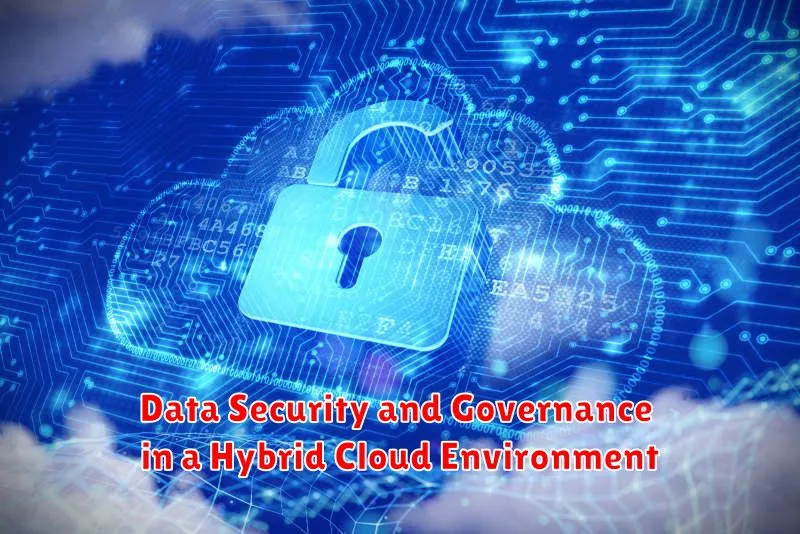
The adoption of hybrid cloud solutions offers businesses significant advantages in terms of agility, cost-effectiveness, and scalability. However, managing data security and governance in a hybrid environment presents unique challenges. Organizations must navigate the complexities of maintaining data integrity, confidentiality, and compliance across multiple platforms and locations.
Data Security is paramount in hybrid cloud environments. As data resides in both on-premises and cloud infrastructure, organizations must implement comprehensive security controls. This includes access management, encryption, firewalls, intrusion detection systems, and regular security audits. Establishing clear data security policies and procedures that align with industry best practices is crucial to mitigate risks.
Data Governance plays a vital role in ensuring data quality, consistency, and compliance. In a hybrid cloud setting, organizations must establish clear data ownership, data lifecycle management, and data retention policies. This includes data classification, access control, and data backup and recovery strategies. Data governance frameworks should encompass both on-premises and cloud environments to ensure consistency and regulatory compliance.
Compliance is another critical aspect of data security and governance in a hybrid cloud. Organizations need to ensure that data is handled in accordance with relevant regulations such as GDPR, HIPAA, and PCI DSS. Regular compliance audits and assessments are essential to maintain adherence to these standards.
Best Practices for data security and governance in a hybrid cloud environment include:
- Adopting a zero-trust security model.
- Implementing strong encryption for data at rest and in transit.
- Using multi-factor authentication for user access.
- Regularly monitoring and updating security configurations.
- Establishing clear data retention and deletion policies.
- Leveraging cloud-native security tools and services.
By prioritizing data security and governance, organizations can unlock the full potential of hybrid cloud solutions while mitigating risks and ensuring compliance. A well-defined strategy that addresses these critical areas enables businesses to embrace agility and efficiency while safeguarding their valuable data assets.
Managing and Orchestrating Your Hybrid Cloud Infrastructure
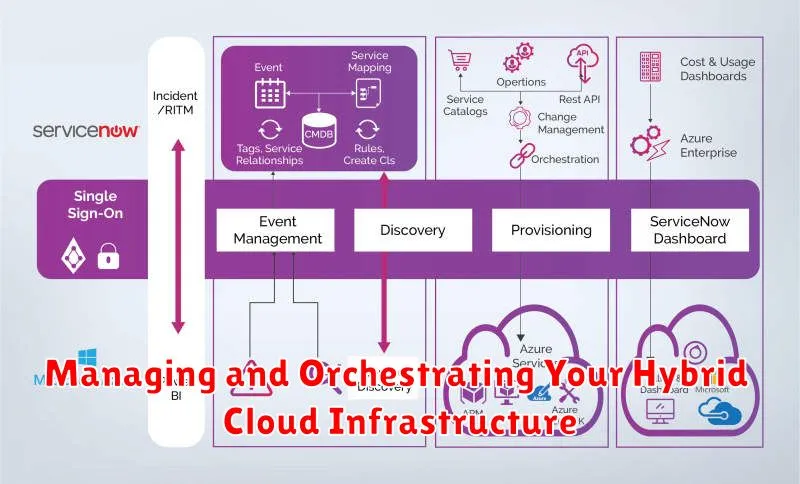
As businesses navigate the complexities of digital transformation, hybrid cloud solutions have emerged as a compelling strategy. This approach offers the best of both worlds, combining the agility and scalability of public clouds with the control and security of on-premises infrastructure. However, effectively managing and orchestrating a hybrid cloud environment presents unique challenges. This article delves into the crucial aspects of managing and orchestrating your hybrid cloud infrastructure, empowering you to unlock true agility and efficiency.
Unified Visibility and Control
Managing a hybrid cloud necessitates a comprehensive view across your diverse environments. A unified management platform provides centralized monitoring, logging, and reporting, enabling you to gain real-time insights into the health, performance, and security of your entire infrastructure. This visibility empowers you to make informed decisions, optimize resource utilization, and proactively address potential issues.
Automated Orchestration and Deployment
Orchestration plays a vital role in streamlining the deployment and management of applications and services across your hybrid cloud. By automating the provisioning, configuration, and scaling of resources, you can accelerate application delivery, reduce manual errors, and enhance operational efficiency. This includes seamlessly deploying applications to the optimal cloud environment based on factors like cost, performance, and security requirements.
Security and Compliance Across Environments
Maintaining security and compliance in a hybrid cloud is paramount. You need to implement a consistent security posture across your on-premises and public cloud environments. This involves integrating security tools, enforcing access controls, and establishing robust data encryption mechanisms. Additionally, ensure compliance with relevant regulations and industry standards across all your cloud deployments.
Cost Optimization and Resource Management
Hybrid cloud solutions offer flexibility in resource allocation, but managing costs effectively requires careful planning and optimization. Leverage automation tools to monitor resource consumption, identify areas for cost reduction, and automatically scale resources based on demand. By optimizing resource allocation and adopting cloud-native services, you can optimize your cloud expenditure.
Conclusion
Managing and orchestrating a hybrid cloud infrastructure is a strategic imperative for businesses seeking agility, efficiency, and cost optimization. By implementing a unified management platform, embracing automation, prioritizing security and compliance, and optimizing resource allocation, you can effectively manage your hybrid cloud environment and unlock its full potential. This approach empowers you to adapt to evolving business demands, innovate with speed, and gain a competitive edge in the digital landscape.
Best Practices for Hybrid Cloud Success
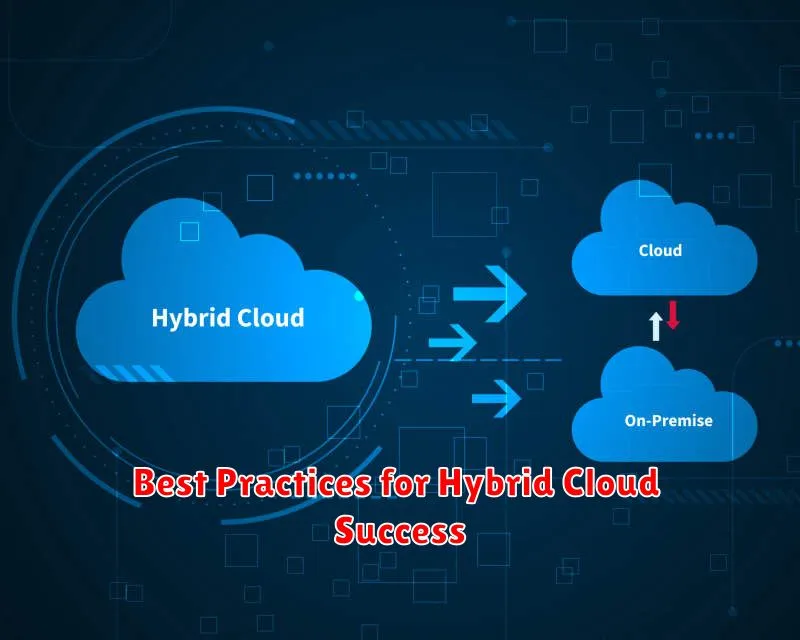
Hybrid cloud solutions offer a powerful approach to optimizing IT infrastructure, combining the best aspects of public and private clouds. To fully unlock the potential of a hybrid cloud strategy, it’s crucial to adopt best practices that ensure agility, efficiency, and seamless integration. This article will delve into essential best practices for achieving hybrid cloud success.
Define Clear Objectives
Before embarking on a hybrid cloud journey, clearly define your objectives. What specific business challenges are you aiming to address? Are you seeking improved scalability, reduced costs, or enhanced security? Having a clear understanding of your goals will guide your decision-making process and ensure your hybrid cloud implementation aligns with your strategic needs.
Choose the Right Cloud Provider
Selecting the right cloud provider is paramount. Research different providers and their offerings carefully. Consider factors like pricing, security, compliance, and the availability of specific services that align with your requirements. Evaluating each provider’s strengths and weaknesses will help you choose the best fit for your organization.
Optimize Network Connectivity
Strong network connectivity is vital for seamless data exchange between your public and private cloud environments. Invest in robust network infrastructure and ensure secure connections to avoid latency and performance issues. Consider using a dedicated network for hybrid cloud traffic to minimize potential bottlenecks.
Implement Robust Security Measures
Security should be a top priority in any cloud environment. Implement comprehensive security measures, including firewalls, intrusion detection systems, and encryption, to safeguard your data and applications. Regularly review and update security protocols to stay ahead of evolving threats.
Leverage Automation and Orchestration
Automation and orchestration tools can streamline hybrid cloud management, reducing manual tasks and potential errors. Implement tools that automate resource provisioning, scaling, and other key processes. This approach enhances efficiency and allows you to focus on strategic initiatives.
Embrace Continuous Monitoring and Optimization
Monitor your hybrid cloud environment continuously to identify potential issues, bottlenecks, and areas for improvement. Utilize performance monitoring tools and gather insights into resource usage, application performance, and security events. By regularly analyzing data, you can optimize your hybrid cloud strategy and ensure optimal performance.
Foster Collaboration and Communication
Hybrid cloud success relies on effective collaboration and communication among IT teams, cloud providers, and business stakeholders. Establish clear communication channels, define roles and responsibilities, and encourage open dialogue to ensure everyone is aligned on objectives and progress.
The Future of Hybrid Cloud Solutions
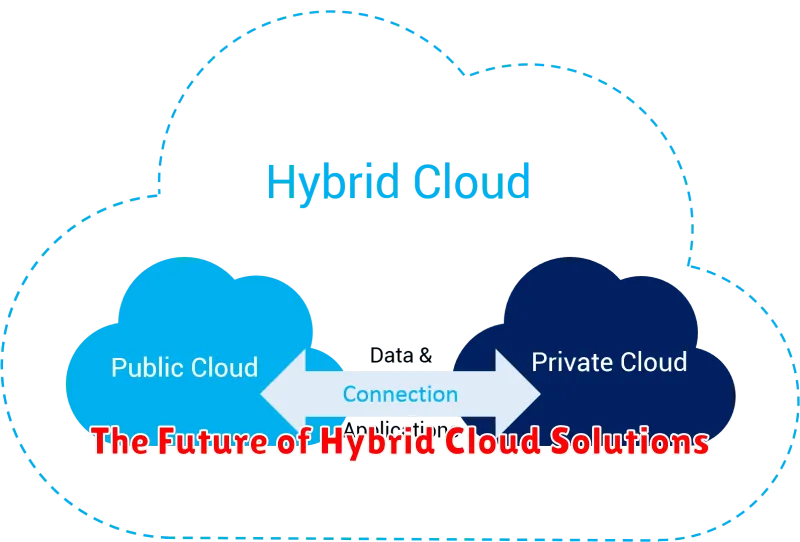
The future of cloud computing is undoubtedly hybrid. Organizations are increasingly realizing the benefits of a multi-cloud strategy, leveraging the strengths of different cloud providers and on-premises infrastructure to achieve optimal agility and efficiency. This hybrid approach offers a unique combination of flexibility, scalability, and cost-effectiveness, paving the way for businesses to unlock their full potential.
As we move forward, hybrid cloud solutions will continue to evolve, driven by several key trends. One prominent trend is the emergence of edge computing, which brings compute power and data storage closer to users, reducing latency and enabling real-time applications. This will enhance the capabilities of hybrid cloud environments by extending their reach and enabling more responsive services.
Another crucial trend is the increasing adoption of artificial intelligence (AI) and machine learning (ML). These technologies will be instrumental in optimizing hybrid cloud infrastructure, automating tasks, and enhancing security. By leveraging AI and ML, businesses can gain valuable insights from their data, streamline operations, and proactively identify and mitigate potential threats.
The future of hybrid cloud solutions is also intertwined with the rise of serverless computing. This approach allows developers to focus on building applications without managing underlying infrastructure, further simplifying the cloud experience. Serverless computing will seamlessly integrate with hybrid cloud environments, enabling organizations to scale their applications with ease and achieve greater cost efficiency.
In conclusion, hybrid cloud solutions are poised to be at the forefront of the future of cloud computing. With the convergence of cutting-edge technologies, such as edge computing, AI/ML, and serverless computing, hybrid cloud environments will offer unparalleled flexibility, scalability, and efficiency, empowering organizations to embrace the transformative power of cloud computing and achieve their business goals.

